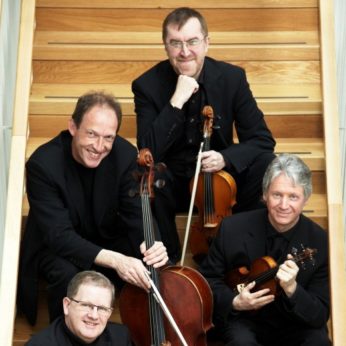Composer: John Gibson (b. 1951)
Performance date: 26/06/2006
Venue: Bantry Library
Composition Year: 2005-6
Duration: 00:16:53
Recording Engineer: Anton Timoney, RTÉ lyric fm
Instrumentation: 2vn, va, vc
Instrumentation Category:String Quartet
Commission: Commissioned by West Cork Music with funds from The Arts Council/An Chomhairle Ealaion
Artists:
RTÉ Vanbrugh Quartet (Gregory Ellis, Keith Pascoe [violins], Simon Aspell [viola], Christopher Marwood [cello]) -
[quartet]

This is the third of
my string quartets. The title might serve to suggest to the listener the nature
and atmosphere I wished to create. The icon in question is a twelfth century
Byzantine image, in a cruciform halo, of the head of Christ. This image is
known as “not made by human hands”.
In other words, the image was received, not fabricated; divine, not human. So,
in the same way, I received the opening motif, complete in its setting. The
following ten meditations evolved in a series of elaborations which again were
received, after a gestation period of some months. Much of the material used is
based on the opening statement, while fragments of the Irish lament “Anach Cuan” are also used. In some
meditations new ideas are employed and integrated.
Throughout these ten
meditations which are played without a break, I had the joy of exploiting the
ability of strings to sustain long cantilena. I use dissonance to create a
colourful and piquant character. The varied rhythmic structure maintains the
forward momentum and changing moods. Devices particular to string writing are
employed, e.g., natural and artificial harmonics, double stopping and
pizzicato.
String writing, imaginatively
composed helps to create a complex web of sonority which results in a quasi
orchestral texture .At the same time, a delicate and refined control of tone
colour and subtlety is possible. Throughout this work the note “E” at various
pitches is used and played in a sustained manner. It has a major significance
and creates a stillness which balances rest and activity. Most importantly, the
opening statement is a fragment of a Kyrie
which can be heard in monasteries throughout the Christian world. It is sung at
Compline or night prayer. This chant is only heard in full at the end of the
work in Meditation ten. At the same time it is broken into constituent phrases with
linking passages. These are built on sweeping arpeggios (first heard in the
last meditation), and rising and falling intervals of a third, which act as a
foil to the chant. In the Coda, the emphasis of the note “E” heard first at the
beginning of the work and played three, sometimes four octaves apart, supports
the fragmentary statements of the chant, heard in fourths and fifths. At this
stage in the work we hear four ecstatic utterances of the opening motif,
(slightly changed), each statement building in intensity and heralding the
ending of the piece. Finally we hear the ubiquitous “E” played four octaves
apart and fading over two bars. The work returns in silence to its origins, and
the mystery of creation, of music, art, faith, is acknowledged in silent
worship and in peace.
This
work, with its Orthodox title and its use of Gregorian Chant is not primarily
religious. It uses sacred images in an exploration of the spiritual. In its
marriage of eastern and western influences, it embraces both. These influences
act as a spiritual backdrop. And so the language of the soul is heard in a
broad tapestry. The fact that the symbols used are Christian does not restrict
the piece to this faith. The appeal is made to every spiritual tradition and
none.
Copyright © 2025 West Cork Music. All rights reserved.
Designed and developed by Matrix Internet